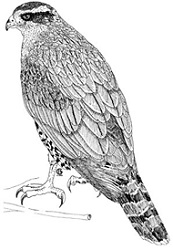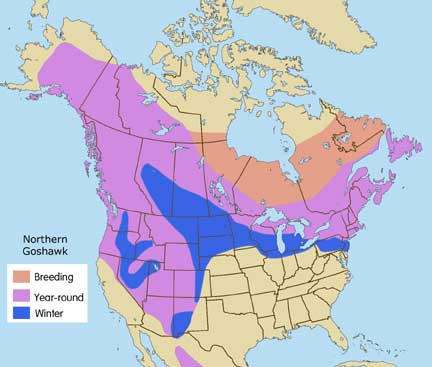
Scientific Name: Astur atricapullus
The largest of the forest hawks and is considered to be “rare to uncommon” over most of its range. The smallest male goshawk, in juvenile plumage, can be difficult to distinguish from a large female Cooper’s hawk. However, in adult plumage, the “grey ghost” is uniformly grey on the back, with a dark grey to black grey cap on its head, a white, pronounced eyebrow over the eye, and distinguished feathery pin-striping of grey-black on pale grey/white on the front. The undertail coverts are white, often quite fluffy, and the tail itself is dark grey above with inconspicuous broad, dark bands; the tail often has a thin white terminal tip. The eye color changes from yellow in immatures to orange or red in the adult birds. This aggressive bird is capable of taking a wide range of prey – crashing straight into and through brush on a chase. It has a well-earned reputation of defending the nest from all intruders, including humans. The short, rounded wings and long rudder-like tail of this bird are well designed for quick maneuvering through its forest habitat.
Male
Length: 21 – 23″ ave.
Wingspan: 40 – 44″
Weight: 1.4 – 2.7 lb.
Female
Length: 22 – 26″ ave.
Wingspan: 43 – 47″
Weight: 1.5 – 3.0 lb.
State and federally protected, the goshawk has come up for consideration for listing under the Endangered Species Act, causing some controversy but to date failure to list. The bird’s large territories, solitary habits, and somewhat limited migrations make it very difficult to monitor for population trends.
Varies; some preference exists for mature forest, at least for nesting; it will forage in open areas. Dense canopy is one of the most uniform requirements of nest stands, as this may reduce predation and, along with the placement of nests along a northern exposure, provide a cooler microclimate for the young. Small forest openings may serve as pathways, provide open country prey.
Varied, as the goshawk is an opportunistic feeder; prey items range from hares and rabbits, to tree squirrels, large perching birds, woodpeckers, game birds, crows and ravens. Occasional reptiles and large insects. Percentage of each type of food varies with region and availability; one study in Oregon demonstrated 42% mammalian prey and 59% avian, but it can range from 82%/18% to 32%/58%. Hunting style is also varied from perch-and-pounce, with short flights between perches; to coursing along forest edges, across openings and through vegetation to surprise prey; to even stalking prey on foot, using ground features for cover.
Usually silent, but can be vocal during courtship and nesting; may vocalize when chasing prey. Calls are similar to other accipiters, but louder and fuller, with a ki-ki-ki-ki or kak, kak, kak alarm call and several different wail calls.
Builds or refurbishes a stick nest used previously, usually in the tallest tree in a stand; nests in most forest types found throughout its range and at all elevations. In the eastern deciduous forests, goshawks nest in mature hardwood/hemlock stands. In the west, nests are more likely to found in pines or firs, though will nest in aspen or birch if those are the dominant trees.
Not frequently presented to rehabilitation centers as tends to stay away from human settlements; logging of nest trees, gunshot.

The American Goshawk is found primarily across the northern portions of the northern hemisphere (Holarctic).
Special thanks for range maps:
Dan Gleason
BGleason Design & Illustration
Commercial & Scientific Illustration, Graphic Design
CraneDance Communications
Book Production/Design

